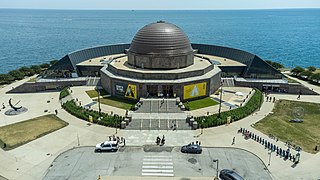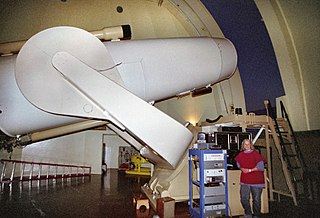
The Adler Planetarium is a public museum in Chicago, Illinois, dedicated to astronomy and astrophysics. It was founded in 1930 by local businessman Max Adler. Located on the northeastern tip of Northerly Island on Lake Michigan, the Adler Planetarium was the first planetarium in the United States. It is part of Chicago's Museum Campus, which includes the John G. Shedd Aquarium and The Field Museum. The Planetarium's mission is to inspire exploration and understanding of the universe.

The B612 Foundation is a private nonprofit foundation headquartered in Mill Valley, California, United States, dedicated to planetary science and planetary defense against asteroids and other near-Earth object (NEO) impacts. It is led mainly by scientists, former astronauts and engineers from the Institute for Advanced Study, Southwest Research Institute, Stanford University, NASA and the space industry.

Maria Mitchell was an American astronomer, librarian, naturalist, and educator. In 1847, she discovered a comet named 1847 VI that was later known as "Miss Mitchell's Comet" in her honor. She won a gold medal prize for her discovery, which was presented to her by King Christian VIII of Denmark in 1848. Mitchell was the first internationally known woman to work as both a professional astronomer and a professor of astronomy after accepting a position at Vassar College in 1865. She was also the first woman elected Fellow of the American Academy of Arts and Sciences and the American Association for the Advancement of Science.

The University of Hawaiʻi at Hilo is a public university in Hilo, Hawaiʻi. It is one of ten campuses of the University of Hawaiʻi System. It was founded as Hilo Center at Lyman Hall of the Hilo Boys School in 1945 and was a branch campus of the University of Hawaiʻi at Mānoa. In 1970 it was reorganized by an act of the Hawaiʻi State Legislature and became a campus within the newly created University of Hawaiʻi System.

Janet Hanula Mattei was a Turkish-American astronomer who was the director of the American Association of Variable Star Observers (AAVSO) from 1973 to 2004.

Florida Institute of Technology is a private research university in Melbourne, Florida. The university comprises four academic colleges: Engineering & Science, Aeronautics, Psychology & Liberal Arts, and Business. Approximately half of Florida Tech's students are enrolled in the College of Engineering & Science. The university's 130-acre primary residential campus is near the Melbourne Orlando International Airport and 16 miles from Patrick Space Force Base. The university was founded in 1958 as Brevard Engineering College to provide advanced education for professionals working in the U.S. space program at the Kennedy Space Center and Space Launch Delta 45 at Cape Canaveral Space Force Station. Since 1966, when it combined the Institute of Technology following University of Central Florida's name change, Florida Tech has gone by its current name Florida Tech. In 2021, Florida Tech had an on-campus student body of 5,693 between its Melbourne Campus, Melbourne Sites, and Education Centers, as well as 3,623 students enrolled in their online programs, almost equally divided between graduate and undergraduate students with the majority focusing their studies on engineering and the sciences. Florida Tech is classified among "R2: Doctoral Universities – High research activity".

The Oak Ridge Observatory, also known as the George R. Agassiz Station, is located at 42 Pinnacle Road, Harvard, Massachusetts. It was operated by the Center for Astrophysics | Harvard & Smithsonian as a facility of the Smithsonian Astrophysical Observatory (SAO) from 1933 until August 19, 2005.

The Inter-University Centre for Astronomy and Astrophysics (IUCAA) is an autonomous institution set up by the University Grants Commission of India to promote nucleation and growth of active groups in astronomy and astrophysics in Indian universities. IUCAA is located in the University of Pune campus next to the National Centre for Radio Astrophysics, which operates the Giant Metrewave Radio Telescope. IUCAA has a campus designed by Indian architect Charles Correa.

The Samuel Oschin telescope, also called the Oschin Schmidt, is a 48-inch-aperture (1.22 m) Schmidt camera at the Palomar Observatory in northern San Diego County, California. It consists of a 49.75 inches (1.264 m) Schmidt corrector plate and a 72 inches (1.8 m) (f/2.5) mirror. The instrument is strictly a camera; there is no provision for an eyepiece to look through it. It originally used 10 inches (25 cm) and 14 inches (36 cm) glass photographic plates. Since the focal plane is curved, these plates had to be preformed in a special jig before being loaded into the camera.

The Indian Astronomical Observatory (IAO) is a high-altitude astronomy station located in Hanle, India and operated by the Indian Institute of Astrophysics. Situated in the Western Himalayas at an elevation of 4,500 meters (14,764 ft), the IAO is one of the world's highest located sites for optical, infrared and gamma-ray telescopes. It is currently the tenth highest optical telescope in the world.

The Maria Mitchell Observatory in Nantucket, Massachusetts, USA, was founded in 1908 and named in honor of Maria Mitchell, the first American woman astronomer. It is a major component of the Maria Mitchell Association. The Observatory actually consists of two observatories - the main Maria Mitchell Observatory near downtown Nantucket and the Loines Observatory about a kilometer west of town. It is also the repository for a valuable collection of over 8000 wide-field glass photographic plates, recording observations of large swaths of sky from 1913 to 1995.

The Vassar College Observatory is an astronomical observatory of the private Vassar College, located near the eastern edge of the Poughkeepsie, New York college's campus. Finished in 1865, it was the first building on the college's campus, older even than the Main Building, with which it shares the status of National Historic Landmark. The observatory's significance is due to its association with Maria Mitchell, the first widely known female astronomer in the United States.

Mary Watson Whitney was an American astronomer and was the head of the Vassar College Observatory for 22 years, where 102 scientific papers were published under her guidance.

The Old University of Alabama Observatory, now known as Frederick R. Maxwell Hall, was an astronomical observatory owned and operated by the University of Alabama in Tuscaloosa, Alabama. Although no longer used as an observatory, the building has been restored and preserved. It currently houses the university's Collaborative Arts Research Initiative (CARI), an interdisciplinary, arts-focused research engine driven by the interests of faculty from across the university. By facilitating collaborations across disciplines, CARI maximizes the impact of faculty arts research, while enriching the university, local, and regional communities. Significant for its architectural and historical importance, it was added to the National Register of Historic Places on January 14, 1972.

A public aquarium (pl. aquaria) or public water zoo is the aquatic counterpart of a zoo, which houses living aquatic animal and plant specimens for public viewing. Most public aquariums feature tanks larger than those kept by home aquarists, as well as smaller tanks.

The Alan Turing Building, named after the mathematician and founder of computer science Alan Turing, is a building at the University of Manchester, in Manchester, England. It houses the School of Mathematics, the Photon Science Institute and the Jodrell Bank Centre for Astrophysics (JBCA). The building is located in the Chorlton-on-Medlock district of Manchester, on Upper Brook Street, and is adjacent to University Place and the Henry Royce Institute.

Leibniz Institute for Astrophysics Potsdam (AIP) is a German research institute. It is the successor of the Berlin Observatory founded in 1700 and of the Astrophysical Observatory Potsdam (AOP) founded in 1874. The latter was the world's first observatory to emphasize explicitly the research area of astrophysics. The AIP was founded in 1992, in a re-structuring following the German reunification.
Davidson-Davie Community College (DDCC) is a public community college with campuses in Davidson County and Davie County, North Carolina. It awards certificates, diplomas, and associate degrees in more than 50 programs. As a member of the Comprehensive Articulation Agreement (CAA), between the North Carolina Community College System and the University of North Carolina (UNC) System, credits earned at DCCC transfer to the university system. Davidson-Davie Community College also provides basic skill training and General Educational Development (GED) programs to the public.

The Maria Mitchell Association Aquarium, also known as the Nantucket Aquarium, is a small, local, seasonal aquarium in Nantucket, Massachusetts. It serves as the island's only marine science center and resource. The Aquarium is one of the many resources offered by the Maria Mitchell Association, a local non-profit organization that promotes scientific education and research in service to the legacy of Maria Mitchell (1818-1889), America's first female astronomer and Nantucket native.

Margaret Harwood was an American astronomer specializing in photometry and the first director of the Maria Mitchell Observatory in Nantucket, Massachusetts. An asteroid discovered in 1960 was named 7040 Harwood in her honor.



















